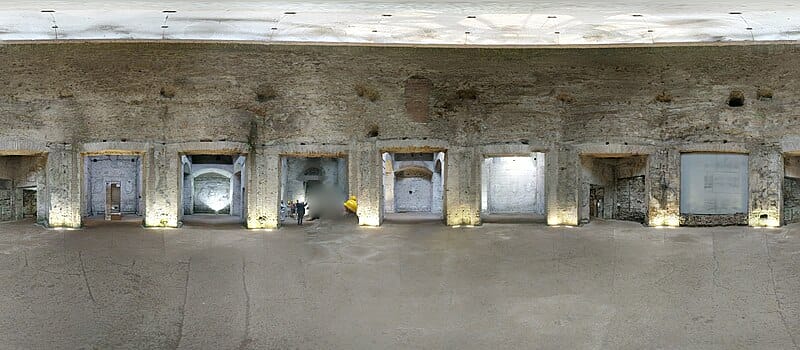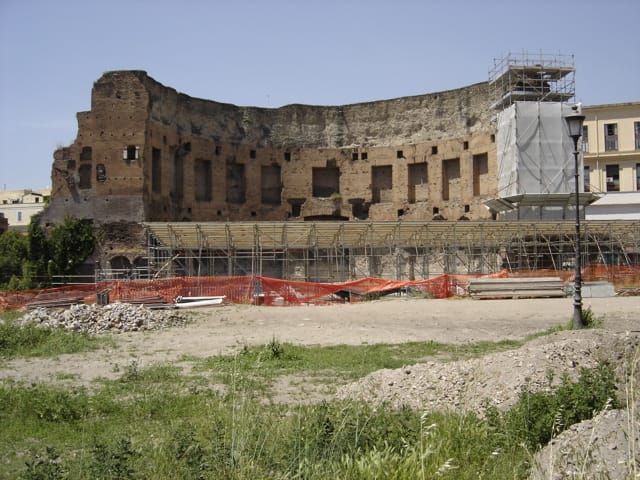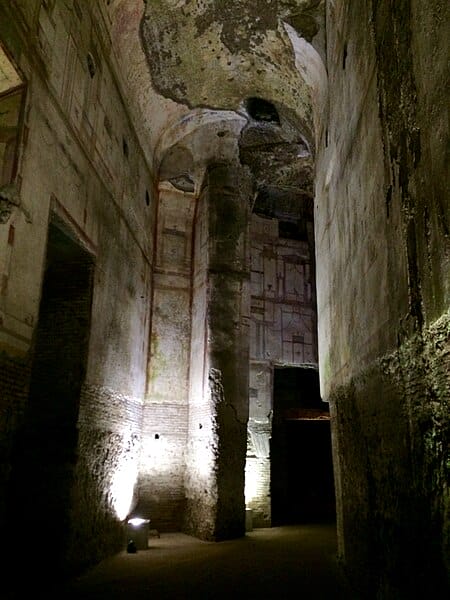In a groundbreaking archaeological discovery, Emperor Nero’s theater, buried beneath the bustling streets of modern Rome, has been unearthed. This remarkable find offers a rare glimpse into the brilliance and extravagance of ancient Roman entertainment, shedding new light on the legacy of one of history’s most notorious rulers. The ancient city of Rome, steeped in history and myth, has long captivated the imagination of scholars, historians, and archaeologists alike. Its labyrinthine streets and towering monuments bear witness to millennia of human endeavor, preserving the stories of emperors, gladiators, and philosophers. The eternal city never ceases to unveil its ancient secrets.

Nero, the enigmatic ruler whose reign was marked by both brilliance and brutality, left an indelible mark on the cityscape of ancient Rome. His ambitious building projects, extravagant festivals, and controversial reign have been the subject of fascination and debate for centuries. This magnificent structure, situated in the heart of Rome, was a testament to Nero’s power and extravagance, serving as a symbol of his patronage of the arts and his desire to leave a lasting legacy.
The Legend of Nero’s Theater
Emperor Nero, infamous for his tyranny and excesses, was also known for his ambitious building projects. Among these was his grand theater, known as the Domus Aurea, or Golden House. Constructed in the heart of ancient Rome, the theater was a symbol of Nero’s power and extravagance. Its rich design and lavish decorations captivated audiences and solidified Nero’s reputation as a patron of the arts.
Nero’s theater was not simply a venue for entertainment; it was a symbol of his authority and magnificence. Built on the grounds of the Domus Aurea, the theater was designed to impress and awe audiences with its grandeur and extravagance. Its massive seating area could accommodate thousands of spectators, who would gather to witness elaborate performances, including plays, musical concerts, and even gladiatorial contests.

The design of Nero’s theater was a testament to Roman engineering prowess. Constructed on a monumental scale, the theater featured tiered seating arranged in a semi-circular fashion around a central stage. Marble columns adorned the facade, while intricate statues and reliefs decorated the interior, depicting scenes from mythology and Roman history. The stage itself was a marvel of craftsmanship, with elaborate sets and machinery that could create stunning visual effects, such as simulated storms and battles.
Lost and Found
During Nero’s reign, his theater was the embodiment of luxury and sophistication, attracting the elite of Roman society to its lavish performances. However, with Nero’s demise and the subsequent turmoil that engulfed the Roman Empire, the fate of his theater took a dramatic turn. In the aftermath of Nero’s death, his successors sought to distance themselves from his legacy, and the Domus Aurea fell into disrepair and neglect.
Over time, Nero’s theater faded into obscurity, buried beneath layers of earth and debris. As the centuries passed, the city of Rome evolved and expanded, with new buildings and roads covering the remnants of its imperial past. The location of Nero’s theater became a mystery, shrouded in myth and legend, as scholars and historians debated its whereabouts. However, in a twist of fate, archaeologists stumbled upon the remains of the theater while excavating the site for a new hotel in central Rome. The discovery sparked excitement and speculation among historians and archaeologists, eager to uncover the secrets hidden beneath the city streets.

Rediscovering Nero’s Legacy
In the modern era, the search for Nero’s theater took on new urgency as archaeologists and historians sought to unravel the secrets of ancient Rome. In a remarkable twist of fate, the remains of Nero’s theater were rediscovered during excavation work for a new hotel in central Rome. The discovery sent shockwaves through the archaeological community, reigniting interest in Nero’s reign and his architectural achievements.
As excavation efforts intensified, the true scale and significance of the discovery began to emerge. The remains of Nero’s theater revealed a sprawling complex, complete with seating areas, stage structures, and intricate architectural features. Excavations at the site revealed the extent of Nero’s theater, with sections of the seating area, stage structures, and decorative elements still intact. Fragments of marble statues, ornate decorations, and elaborate frescoes adorned the walls, offering a glimpse into the extravagance of ancient Roman entertainment. The discovery provided invaluable insights into the design and construction of Nero’s theater, shedding new light on the cultural and artistic achievements of the Roman Empire.
The Impact of Nero’s Theatre Discovery
With the excavation of Nero’s theater comes the responsibility to preserve and protect this priceless archaeological treasure. The rediscovery of Nero’s theater has sparked a renewed appreciation for the emperor’s architectural legacy and his contributions to Roman culture. Efforts are underway to ensure that the remains are protected for future generations, allowing scholars and visitors alike to continue exploring and learning from Rome’s rich history. Conservationists are working to stabilize the structures and prevent further deterioration, while plans are being made to open the site to the public, allowing visitors to experience the grandeur of Nero’s theater firsthand. By preserving Nero’s theater, we honor the legacy of the past and ensure that its story endures for generations to come.

The discovery of Emperor Nero’s lost theater offers a captivating glimpse into the gloriousness and spectacle of ancient Rome. The rediscovery of Nero’s theater offers a glimpse into the past, allowing us to explore the rich history and legacy of one of history’s most enigmatic rulers. As efforts continue to preserve and protect this priceless archaeological treasure, we are reminded of the enduring significance of Rome’s imperial past and the importance of preserving its cultural heritage for future generations.
People Also Ask:
What happened to Nero’s Theater?
The remains of the theatre were found during excavations in 2020 under the direction of the special archaeological Superintendence of Monuments of Rome. The theatre’s discovery was announced in July 2023 by Rome’s superintendent, Daniela Porro.
What is Nero famous for?
Nero is known as one of Rome’s most infamous rulers, notorious for his cruelty and hedonism. He ascended to power in AD 54, aged just 16, and died at 30. He ruled at a time of great social and political change, overseeing momentous events such as the Great Fire of Rome and Boudica’s rebellion in Britain.
What is Nero’s entertainment?
During the games, Nero sang and played his lyre on stage, acted in tragedies, and raced chariots. He won a 10-horse chariot race despite being thrown from the chariot and leaving the race. He was crowned on the basis that he would have won if he had completed the race.
What was Nero’s problem?
However, like Caligula before him, Nero had a dark side. His impulses began as simple extravagance. Before long, however, stories were circulating that he seduced married women and young boys and that he had castrated and “married” a male slave. He also liked to wander the streets, murdering innocent people at random.
What buildings did Nero build?
With this new land under his control, Nero began construction of his golden palace, the Domus Aurea. As Nero had always hoped, the palace and its associated gardens stretched from the Palatine Hill, across the valley, and up onto the Esquiline Hill, spanning at least 50 hectares in the city center.
Hello, my name is Vladimir, and I am a part of the Roman-empire writing team.
I am a historian, and history is an integral part of my life.
To be honest, while I was in school, I didn’t like history so how did I end up studying it? Well, for that, I have to thank history-based strategy PC games. Thank you so much, Europa Universalis IV, and thank you, Medieval Total War.
Since games made me fall in love with history, I completed bachelor studies at Filozofski Fakultet Niš, a part of the University of Niš. My bachelor’s thesis was about Julis Caesar. Soon, I completed my master’s studies at the same university.
For years now, I have been working as a teacher in a local elementary school, but my passion for writing isn’t fulfilled, so I decided to pursue that ambition online. There were a few gigs, but most of them were not history-related.
Then I stumbled upon roman-empire.com, and now I am a part of something bigger. No, I am not a part of the ancient Roman Empire but of a creative writing team where I have the freedom to write about whatever I want. Yes, even about Star Wars. Stay tuned for that.
Anyway, I am better at writing about Rome than writing about me. But if you would like to contact me for any reason, you can do it at [email protected]. Except for negative reviews, of course. 😀
Kind regards,
Vladimir
